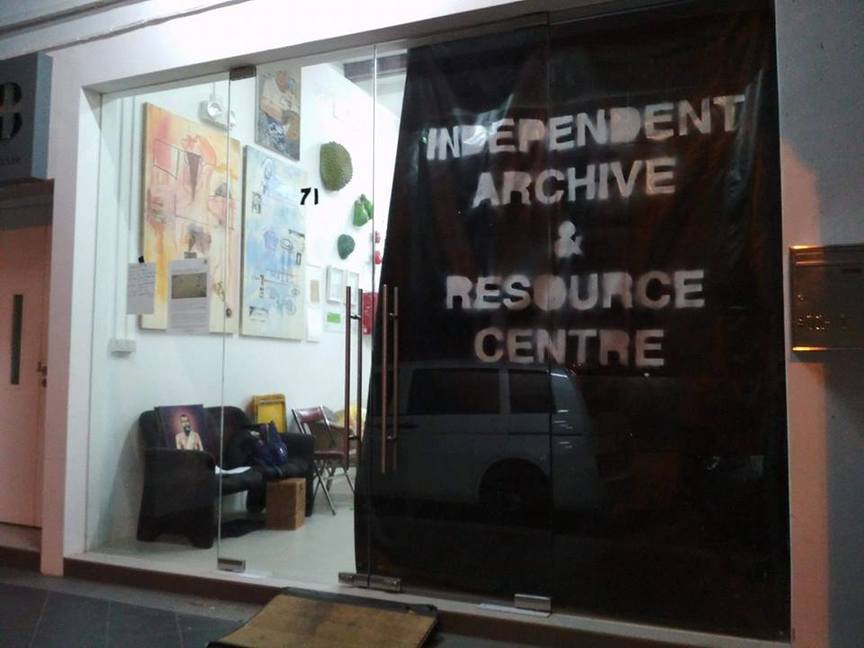
R
E
V N
E
X
T
The Independent Archive (IA) was founded in Singapore in 2012
by the artist Lee Wen (1957–2019) and is one of his last major projects. Formerly named the Independent Archive & Resource Center, the institution consists of a reference library and a collection of archival material pertaining to art in Singapore and
the region. Regular programs—including film screenings, music performances, performance art events, artist talks, and discussions—stimulate open discourse on art.
Lee was deeply attached to IA. During a memorial event for Lee after his death in March, the assistant chief executive of the National Art Council, Low Eng Teong, recalled an encounter where Lee was more concerned with the future of the IA and about the
art and materials that it houses than his own illness and sparse lifestyle.
Towards the end of Lee’s life, IA was taking a toll on him. My experiences with independently run archives have led me to see such endeavors as akin to harboring monsters. In that sense, there is an inherent monstrosity in archives and their ability to consume the archivist—the burden of keeping and making knowledge begins to “devour” you. For this gesture of “bravery,” I respect those who dare keep an archive.
It broke my heart to see Lee juggle his illness with his own artistic practice and his commitment to IA. Many friends would try to advise or persuade him to end this project, but he insisted on keeping IA “alive” until the very end. Lee’s resolve to keep the archive functioning in what is the world’s most expensive city is something I wish to understand. By contextualizing and unpacking Lee’s archival impulse through his work with IA, we can see the materialization of IA as an essential part of his practice.
Let us turn to the concept of the “archive” as it was elaborated in the form of IA. The “archive,” as a concept, is often utilized by artists drawn to unfulfilled beginnings, and tends to embody a utopian ambition to recoup failed visions in art, literature, philosophy and everyday life into possible scenarios of alternative kinds of social relations—to transform the non-place of the archive into the non-place of a utopia, as Hal Foster suggested in his 2004 essay “An Archival Impulse.” In Lee Wen’s case this is reflected in the IA’s focus on documenting ephemeral time-based and event-specific art forms that are not documented by other national institutions in Singapore. Lee’s gesture of invoking the “archive” is a way of seeking alternative knowledge or of counter-memory—a kind of cultural-activist strategy, which is often part solution and critique of the cultural developments in Singapore.
“If the archive is not interrogated, it is dead,” Lee was quoted as saying in an interview for AsiaArtArchive. To some, IA’s programs of film-screenings or musical performances might have appeared out of place in the traditional format of the archive. There is a kind of messy and fuzzy way of making an archive—allowing elements of chaos to descend for no planned reason—as practiced by IA, which I understood to be very “Lee Wen.” Lee never saw archives as passive depositories of knowledge but as a medium, which lead
to a “live process” that could potentially review, re-imagine and re-create “individual, personal as well as social, collective identities and memory,” as he wrote in his Master of Arts thesis. It is apparent and clear, IA was never created to mimic an institutional archive but as a kind of “speculative practice,” as framed by Stefano Harney and Fred Moten—a kind of common intellectual practice in relation to other forms of speculative practices where their activities are fleeting, fringe and deviant. These activities in their fugitive forms often escape depositories but here in IA are instead embedded within them.
The “Independent” in IA can be understood in the context of the state in Singapore. It seems that the perception of the state’s omnipresence in our everyday life and cultural policies would come to result in an unusual cultural eclipse—rendering the inevitable references or relation to the state in our cultural discourses. Lee’s sense of the “Independent” came from the agency
to “make heart, not art”—and to provide a “safe” place for people to come together, and to collectivize because, in Lee’s words from 2018, “We don’t have enough of that.” Lee was deeply invested in the freedoms. He saw IA as a kind of space where one is free to speak one’s mind and be one’s self.
As Lee’s body grew weaker due to Parkinson’s, IA also became his “social body.” Lee loved company and the idea of people collectivizing, as he is always happy and ready to host a passerby or a friend. There was almost no need for an appointment because he made it a point to be at IA as often as his physical body would allow him to perform this “social body.”
Lee’s work revolves around the manifestations of dreams as a way of conjuring impossible projects into the real world. During its lifespan, IA was one of Lee’s impossible projects to which he dedicated a lot of time and resources. In these attempts at reading what made IA both “Independent” and an “Archive,” I want to grasp Lee’s impulse and understand why he was so invested in the ideologies behind IA.
To read more of ArtAsiaPacific’s articles, visit our Digital Library.
















